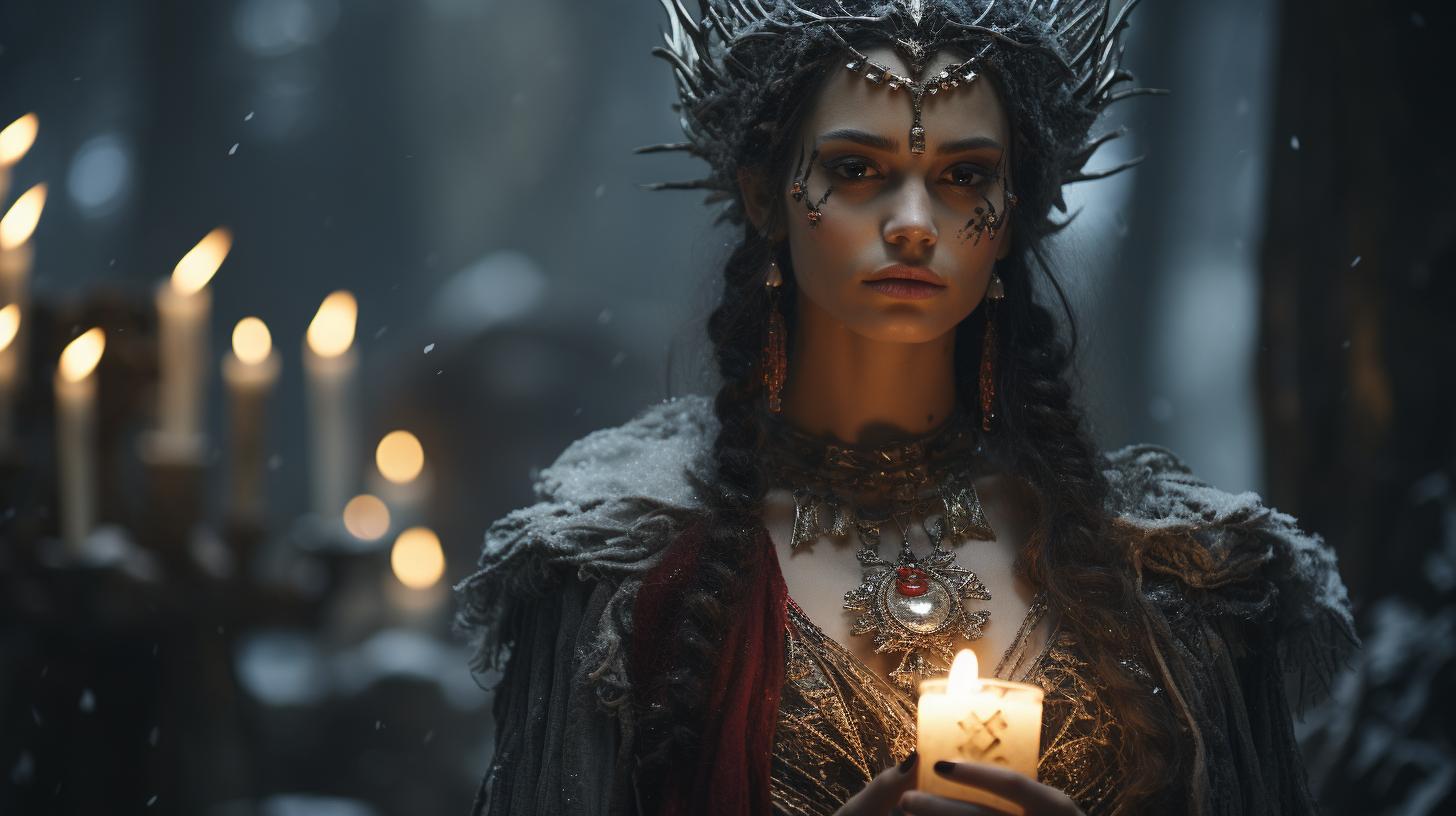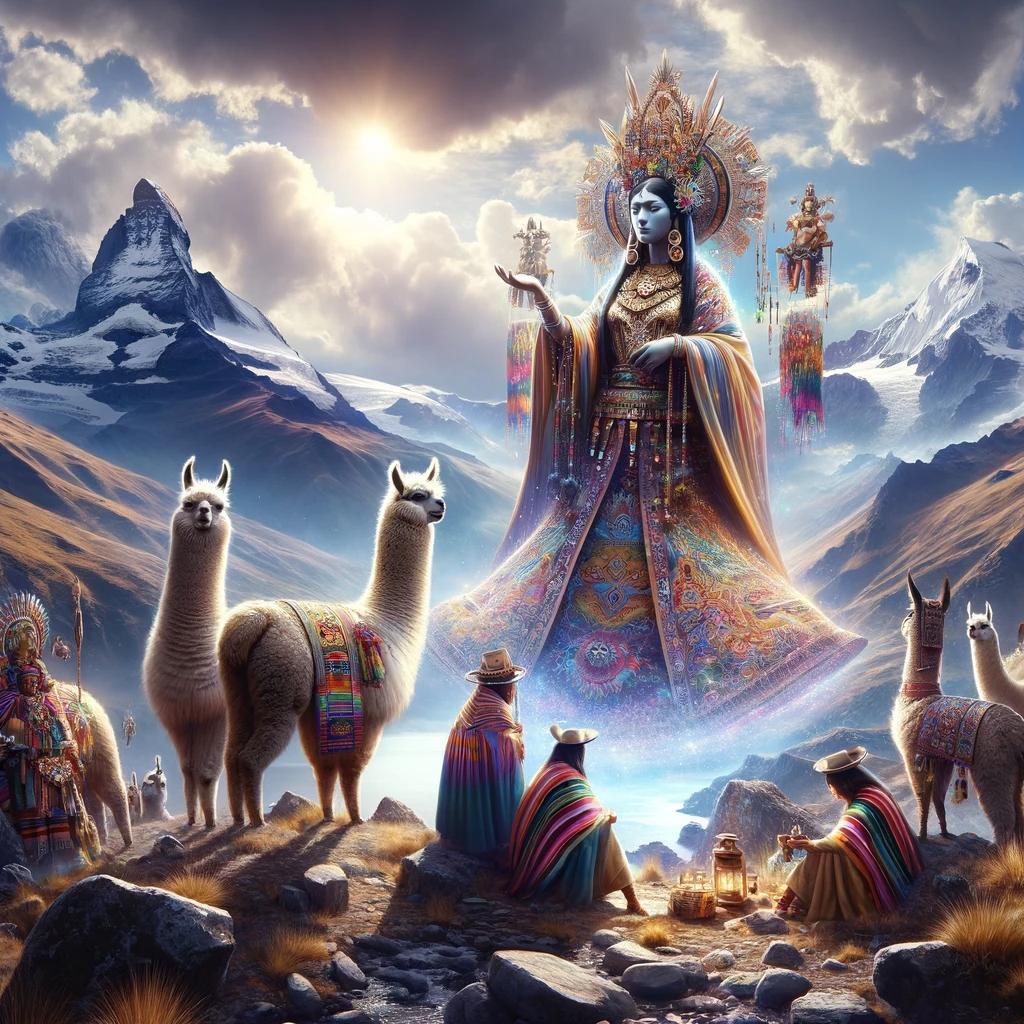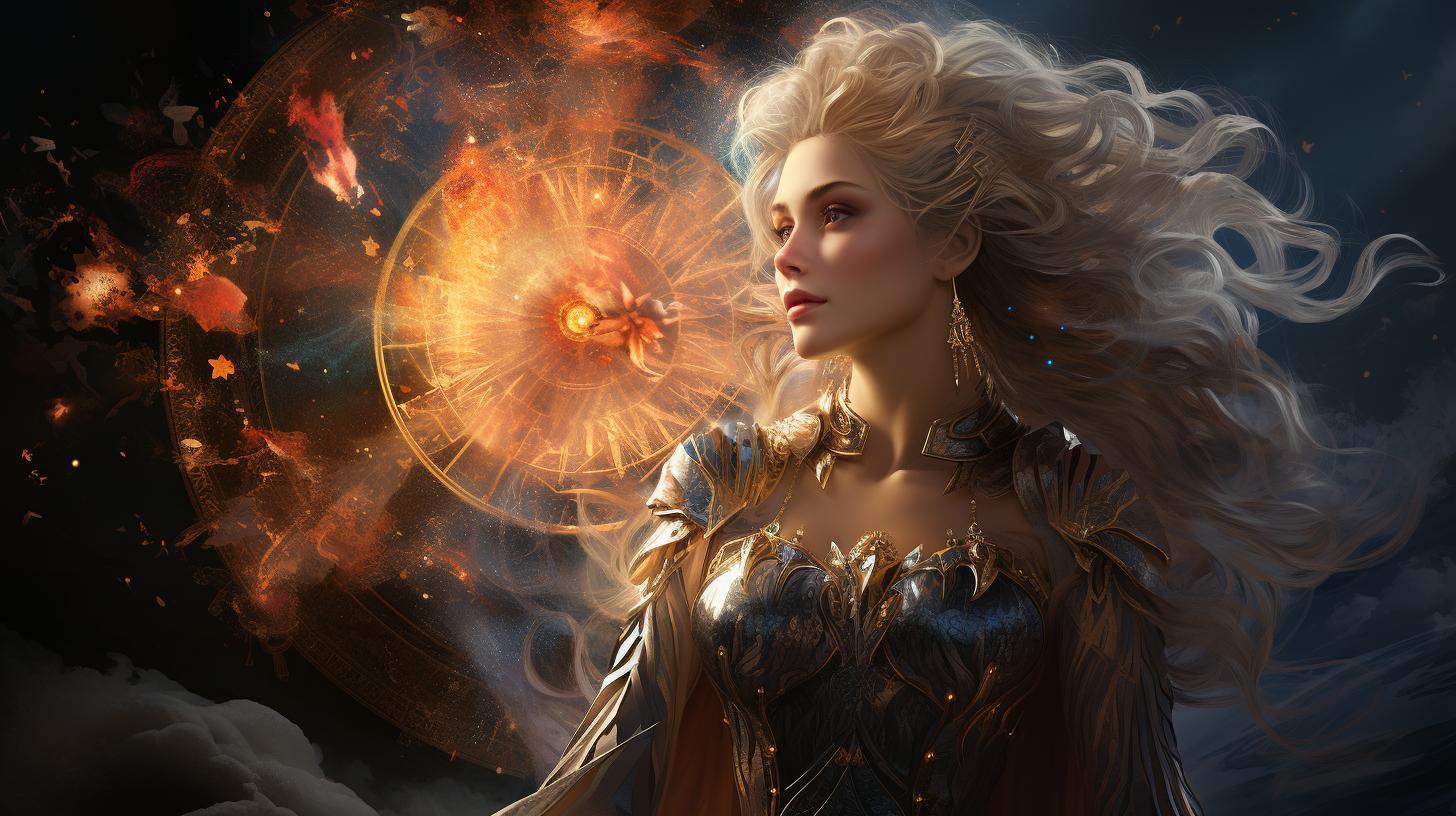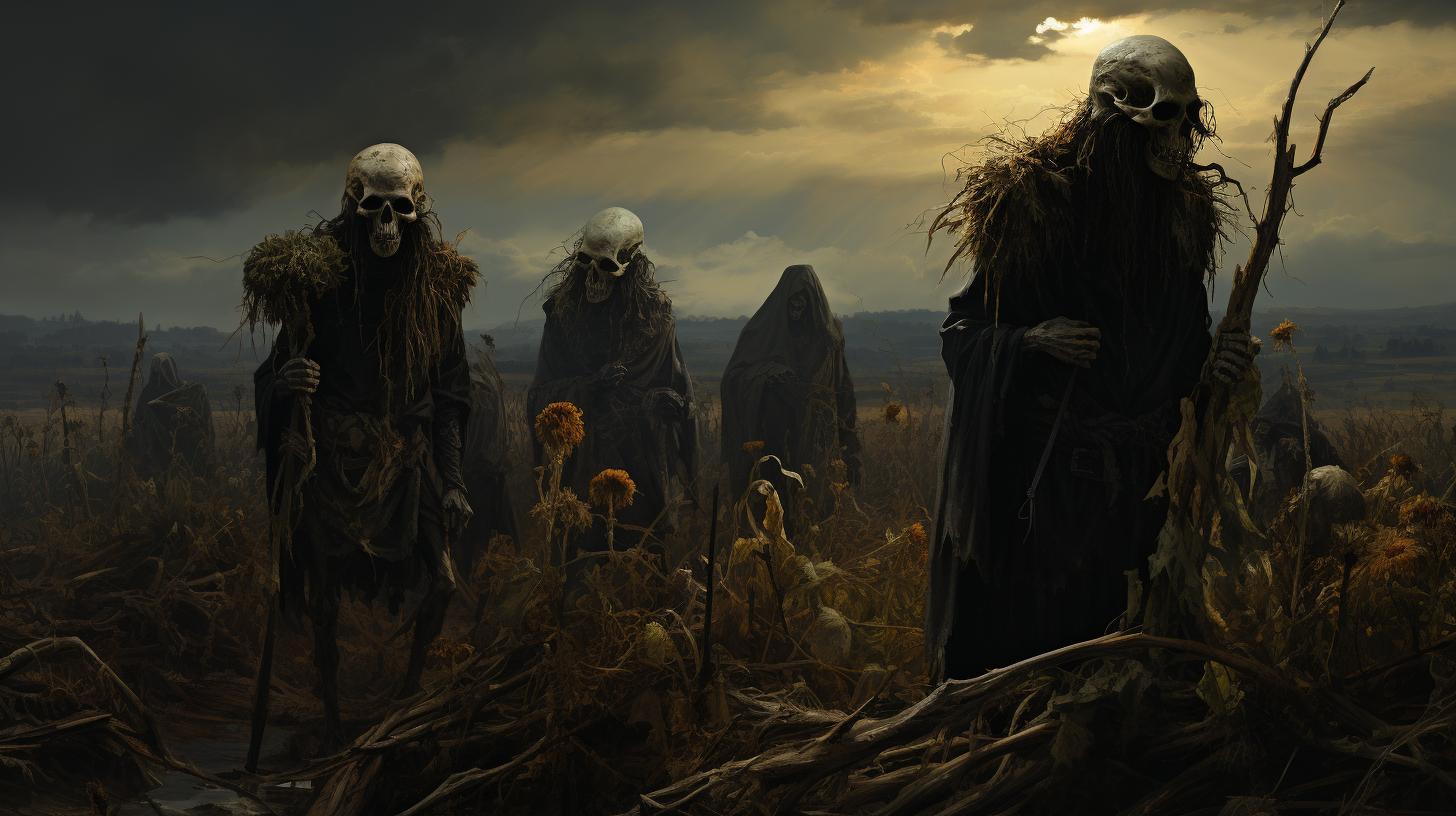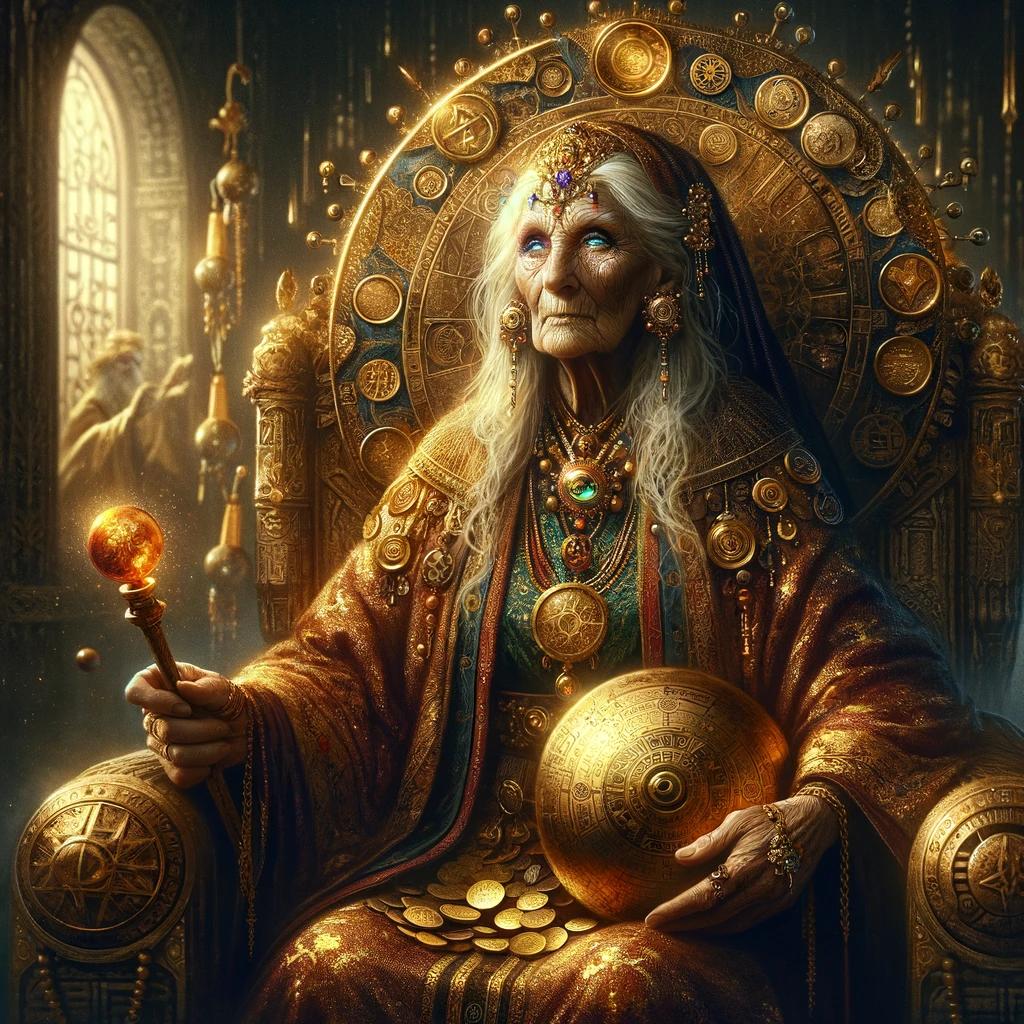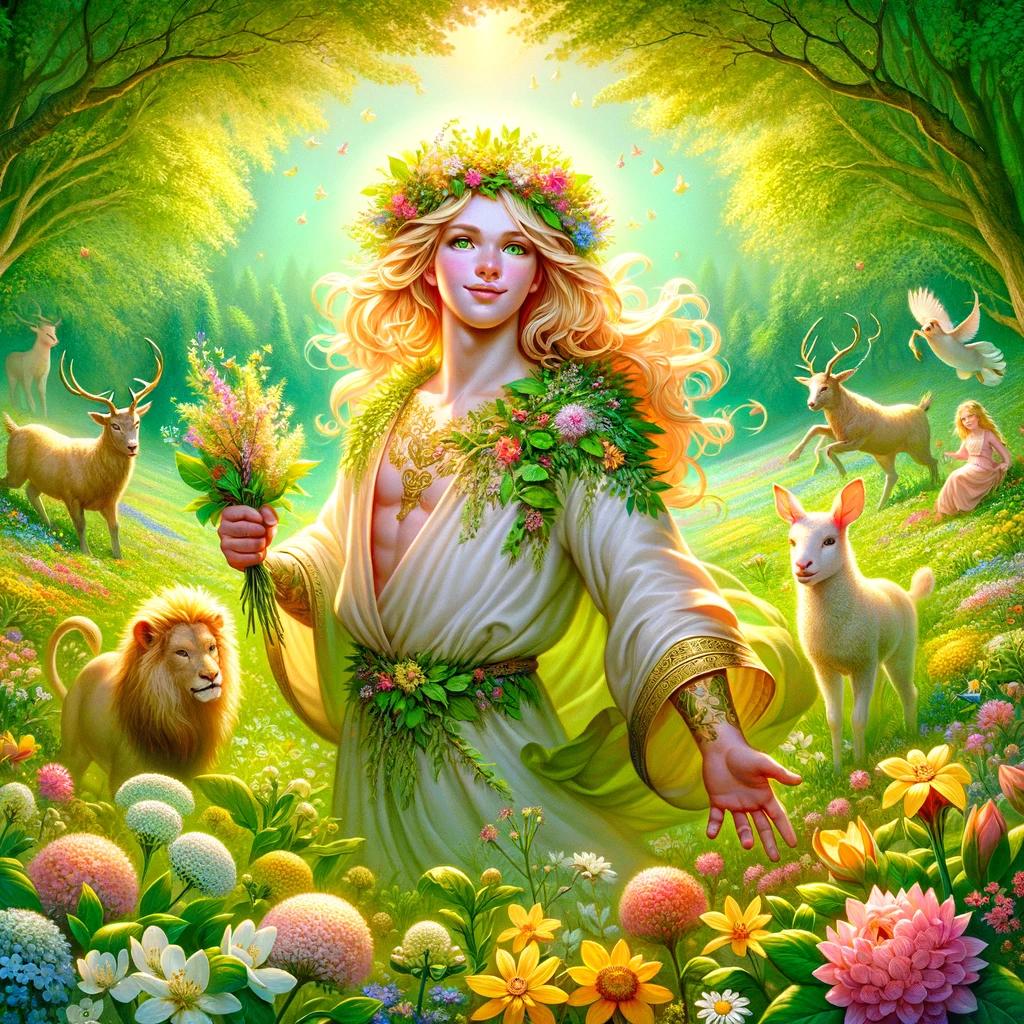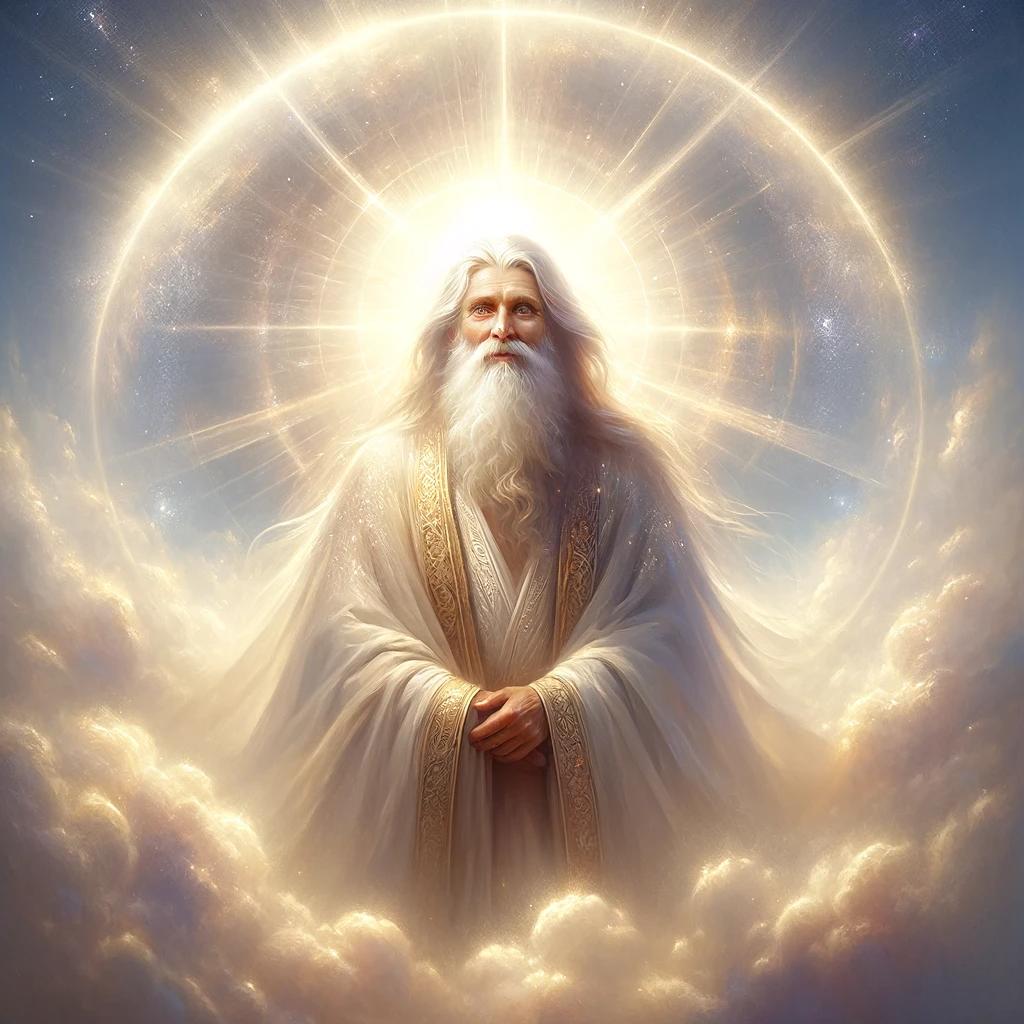Morena, the Goddess of Death: Unveiling the Ancient Slavic Mythology
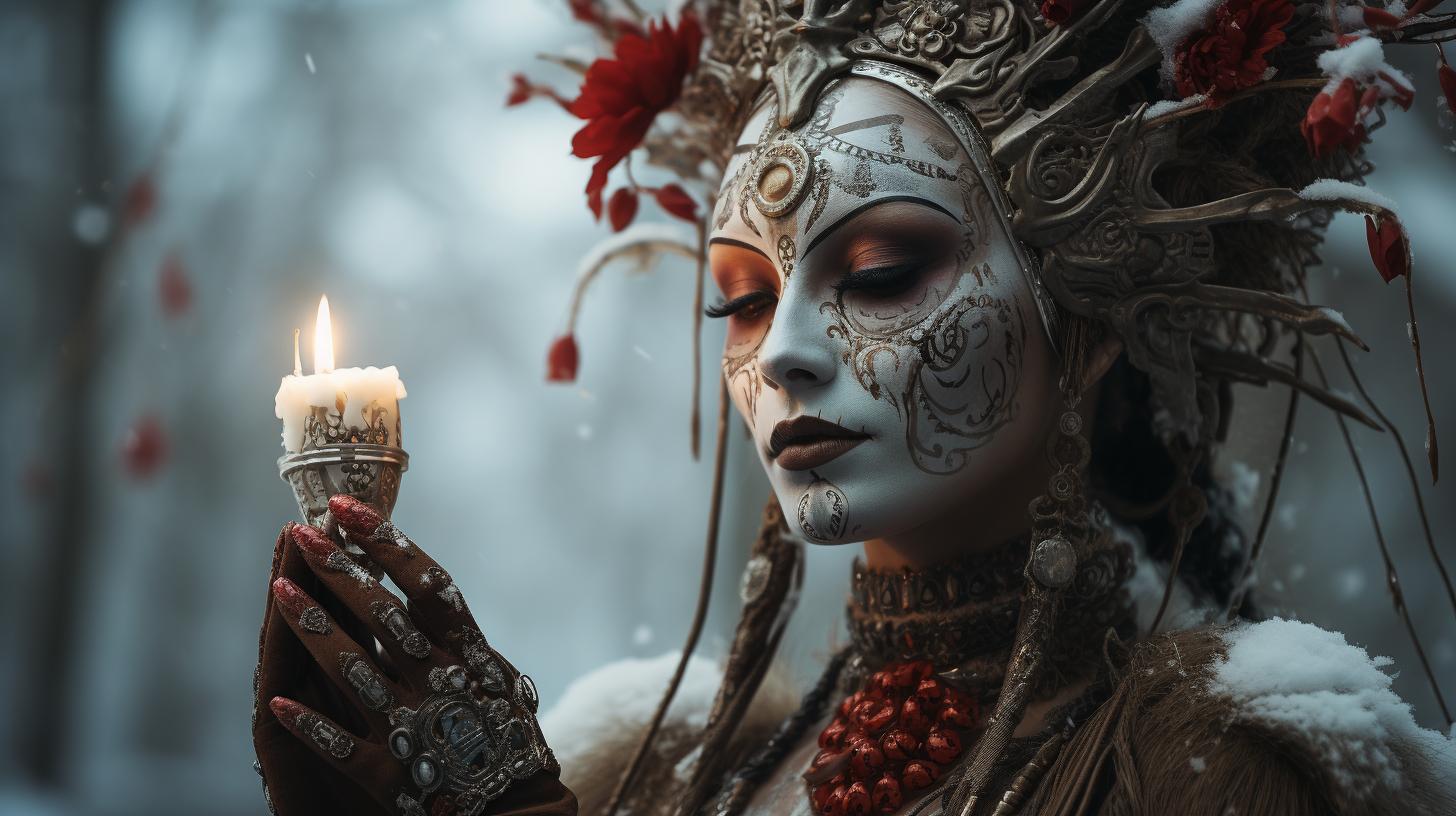
Morena goddess of death, a prominent figure in Slavic mythology, holds significant influence over ancient traditions and rituals. Her portrayal as the harbinger of winter’s end and the beginning of spring is marked by the symbolic drowning of her effigy.
Across various Slavic cultures, Morena takes on different forms, such as Morana in Polish mythology and Marzanna in other Slavic traditions. With associations to evil, witchcraft, and even the enigmatic Baba Yaga, Morena’s allure and insatiable lust have captivated the imagination.
Despite the Catholic Church’s intervention in suppressing Morena rituals, her legacy persists in modern celebrations, albeit with transformed meanings.
Origins of Morena in Slavic Mythology
The goddess Morena holds a significant place in Slavic mythology, captivating imaginations with her enigmatic nature and associations with death. She embodies the cycle of life and the transition from winter to spring, symbolizing the eternal struggle between light and darkness.
Originating from ancient Slavic beliefs, Morena, also known as Morana or Marzanna, represents the forces of nature and the inevitable passage of time. As the goddess of death, she is both feared and revered, embodying the mysteries of the afterlife and the transformative power of nature.
The legends surrounding Morena vary across different Slavic cultures, but the core theme remains consistent – she is the embodiment of the end of winter and the rebirth of nature. Traditionally, the slaying or drowning of her effigy signifies the departure of winter and the arrival of spring.
Over time, Morena has been linked to other deities such as Hecate and Ceres in Christian tradition, highlighting the interconnectedness of different mythologies. Her counterparts in other Slavic cultures include Vesna in Belarusian mythology, Lada in Russian mythology, and Lel in Ukrainian mythology, each representing the arrival of spring and the fertility of the Earth.
The origins of Morena are deeply rooted in ancient Indo-European mythology, showcasing the enduring influence of cultural exchange and shared beliefs. Her presence in Slavic mythology demonstrates the interconnectedness of ancient cultures and their reverence for the cycles of nature.
Through exploring the origins of Morena in Slavic mythology, we gain a deeper understanding of the cultural significance of this captivating goddess. Her role as the embodiment of death and rebirth continues to fascinate and inspire, bridging the gap between the mysteries of the past and the enduring traditions of the present.
Morena, the Goddess of Death: Myth and Legends
Morena, known as the Goddess of Death, holds a significant place in Slavic mythology. Her presence is intertwined with mystical tales and legends that have fascinated generations. Let’s explore the captivating myths surrounding Morena and the enduring legacy she has left behind.
In the realm of Slavic folklore, Morena emerges as a powerful deity associated with the cycle of life and death. She embodies the enigmatic forces that govern the transition from the harsh winter to the rejuvenating spring.
Morena’s narrative is shrouded in darkness and mystery, lending an air of intrigue to her mythos.
Legends portray Morena as a goddess who rules over the underworld and holds sway over the fate of souls.
She is often depicted as a seductress, enthralling mortals with her mesmerizing beauty and irresistible charm. But beneath her alluring facade lies a deeper, more profound symbolism, representing the inevitable cycle of life, death, and rebirth.
- Slavic folklore celebrates Morena as the harbinger of the changing seasons, invoking the significance of her role in the perpetual cycle of nature’s rhythms.
- Mythical tales describe the veneration of Morena during winter festivals, where she is honored through various rituals and customs.
- Her effigy is crafted, embodying the essence of winter, before being ceremoniously burned or drowned, symbolizing the end of winter’s grip and the emergence of spring’s vitality.
- Through these practices, Slavic communities sought to ensure the transition to a prosperous and bountiful season.
Furthermore, Morena’s influence extends beyond Slavic mythology.
Indo-European mythological parallels can be drawn, highlighting the interconnectedness of ancient cultures. Her character bears resemblances to figures such as Hecate and Ceres in Christian traditions, showcasing the universal themes surrounding the concept of death and the afterlife.
The rich tapestry of Slavic folklore reveals additional manifestations of Morena across different cultural contexts. In Polish mythology, she is known as Morana, while in other Slavic regions, such as Belarus, Russia, and Ukraine, she takes different forms, such as Vesna, Lada, and Lel.
These variations demonstrate the diverse interpretations and regional nuances surrounding Morena’s portrayal.
Her association with evil, witchcraft, and supernatural entities further adds to the mystique of Morena. The malevolent presence of Kuga and Mora, entities linked to sickness and misfortune, intertwines with her darker aspects.
Notably, the infamous Baba Yaga, a fearsome figure known for her connection to witchcraft, intersects with Morena’s narrative, enhancing the enigmatic aura surrounding both.
Love and passion also find their place within Morena’s mythos.
Legends speak of her insatiable lust and the misfortune it brings upon those who succumb to her desires. The complexities of human emotions intertwine with her divine nature, creating a compelling narrative of love, suffering, and the pursuit of eternal longing.
While the Catholic Church played a role in suppressing many ancient rituals associated with Morena, her legacy endures in modern Slavic culture. The contemporary celebrations of Morena have transformed, losing their sacred connotations and becoming more of a recreational pastime.
Delving into the tangled web of Slavic mythology, we come to appreciate the multifaceted nature of Morena, the Goddess of Death. Her presence extends beyond mere tales and legends, captivating our imagination and reminding us of the intricate tapestry woven by ancient beliefs.
The rich symbolism and enduring myths associated with Morena continue to resonate, offering glimpses into the enigmatic realms of life, death, and the eternal cycle of nature.
The Influence of Indo-European Mythology on Morena
The mythology surrounding Morena, the goddess of death in Slavic culture, exhibits influences from Indo-European mythology.
These mythological connections highlight the interconnectedness of ancient belief systems and the shared themes that transcend cultural boundaries.
Indo-European mythology, spanning across various ancient cultures, explores concepts of life, death, and the cycle of nature.
Within this framework, many deities representing death, rebirth, and the changing seasons emerge. Morena, with her association with the end of winter and the arrival of spring, aligns closely with these Indo-European concepts.
The parallels between Morena and the god of death in Roman mythology, Pluto, demonstrate how similar themes manifest in different cultural contexts. Pluto, also known as Dis Pater, reigns over the underworld and symbolizes wealth and abundance.
Morena shares these aspects as a goddess embodying both the end of life and the promise of renewal.
The Indo-European influence on Morena is also evident in the various manifestations of the goddess across different Slavic mythologies.
Morana, a version of Morena in Polish mythology, represents the harsh winter and personifies death and decay. In other Slavic cultures, Morena takes on different names such as Marzanna, Vesna, Lada, and Lel, embodying the changing seasons and fertility.
Through the lens of Indo-European mythology, we can discern the interconnectedness of ancient belief systems. Morena’s role as the goddess of death reflects the universal human fascination with the cycle of life and the understanding that death is an inherent part of nature’s continuous renewal.
The influences from Indo-European mythology deepen our understanding of Morena’s significance in Slavic culture and her connection to broader mythological traditions.
A Comparative Analysis: Morena and the God of Death in Roman Mythology
The intriguing parallels between Morena, the Slavic goddess of death, and the Roman god of death warrant a comparative analysis.
While Morena embodies the essence of death in Slavic mythology, the God of Death in Roman mythology is often associated with Pluto, ruler of the Underworld. Both deities hold significant roles in their respective mythologies and have overlapping characteristics and symbolism.
Morena and the God of Death share the common responsibility of presiding over the realm of the deceased. In Slavic culture, Morena is believed to govern the transition from life to death, while the Roman God of Death oversees the underworld realm where departed souls dwell.
This similarity suggests a universal human fascination and fear regarding the concept of death, reflected in multiple mythologies throughout history.
Another notable aspect is the association of both deities with the changing seasons. Morena, as the goddess of death, is closely linked to the end of winter and the rebirth of spring.
Similarly, the God of Death in Roman mythology represents the cycle of life and death, mirroring the changing growth patterns of vegetation in nature. This parallel underscores the interconnectedness of life and death, as well as the eternal cycle of renewal.
- The role of Morena in Slavic mythology includes:
- Presiding over the transition from life to death
- Symbolizing the end of winter and the beginning of spring
- Reflecting the cyclical nature of life and death
- The role of the God of Death in Roman mythology includes:
- Ruling over the realm of the deceased
- Representing the cycle of life and death
- Symbolizing the renewal of vegetation
Despite the similarities, there are also notable differences between Morena and the Roman God of Death.
For instance, while Morena is often portrayed with an alluring yet terrifying persona, the God of Death in Roman mythology is typically depicted as a somber figure. Additionally, their specific domains within the realms of death diverge: Morena is associated with the transition from life to death, while the Roman God of Death governs the underworld.
The comparative analysis of Morena and the God of Death in Roman mythology allows us to delve deeper into the cultural and psychological aspects of mortal existence. It highlights humanity’s shared fascination with death and its integration into various belief systems throughout history.
Understanding these parallels and distinctions sheds light on the complex nature of our perceptions and interpretations of death in different mythologies.
The Traditions and Rituals Associated with Morena in Slavic Culture
The traditions and rituals associated with Morena in Slavic culture encompass a rich tapestry of ancient practices and beliefs.
These customs and ceremonies revolve around the mythological significance of Morena, the goddess of death, and her symbolic representation of the end of winter.
Drowning the Effigy: Symbolizing the End of Winter
One prominent tradition linked to Morena is the act of drowning her effigy, which serves as a symbolic gesture marking the transition from winter to spring.
As the seasons change, communities gather near rivers or lakes to engage in this ritual. The effigy is often created with natural materials, representing the dying winter landscape. It is then cast into the water, signifying the defeat of Morena and the rebirth of nature.
The Role of Morena in Winter Festivals
Morena plays a central role in the vibrant winter festivals celebrated in Slavic culture. These festivals, known for their lively and exuberant nature, serve as a means of bidding farewell to the harsh winter months.
Participants engage in a variety of activities and performances, including music, dance, and theatrical representations depicting the defeat of Morena. These festivities symbolize the triumph of light over darkness and the arrival of the rejuvenating spring season.
The Significance of Copse in Morena Rituals
The copse, an essential element of Morena rituals, holds deep symbolic meaning. It represents a sacrosanct space where the effigy is ceremoniously burned or hung on a tree. The copse serves as a focal point for the community’s collective energy and devotion during these rituals.
It is believed that the smoke from the burning effigy carries away the lingering winter spirits and ushers in the fresh vitality of spring.
The traditions and rituals associated with Morena in Slavic culture are deeply rooted in ancient beliefs and continue to be practiced across various regions.
They serve as a testament to the enduring significance of the goddess of death and her role in the cyclical nature of life, death, and rebirth.
The Goddess of Death Across Different Slavic Mythologies
The realm of Slavic mythology is rich with diverse interpretations of the goddess of death, known as Morena, Morana, or Marzanna.
Each Slavic culture has its own unique perception and representation of this enigmatic deity.
Morana in Polish Mythology
In Polish mythology, Morana is revered as the goddess of death and winter. She is often depicted as a pale and haunting figure, associated with the cold and desolation of the season.
Morana’s presence is especially prominent during the harsh winter months when her influence is believed to be at its strongest.
Morana and Marzanna: Different Manifestations of Morena
While Morana and Marzanna are often used interchangeably in Slavic mythology, they are distinct manifestations of the goddess of death. Morana is specifically associated with winter, representing the bleakness and hardships of the season.
Marzanna, on the other hand, symbolizes the end of winter and the arrival of spring, embodying the cyclical nature of life and death.
Morena’s Counterparts: Vesna, Lada, and Lel
In addition to Morana and Marzanna, there are other deities closely associated with Morena across various Slavic mythologies.
Vesna, in Belarusian mythology, represents the vibrant and revitalizing aspects of spring. Lada, in Russian mythology, is celebrated as the goddess of love, beauty, and fertility, often linked with the cycles of life and death.
Lel, in Ukrainian mythology, personifies the arrival of spring and the renewal of nature, intertwining with the concepts of life and death.
These counterparts highlight the complex and interconnected nature of Slavic mythologies, where the portrayal of the goddess of death is often intertwined with other natural and celestial forces.
Morena’s Associations with Evil and Witchcraft
Morena, the goddess of death in Slavic mythology, is intertwined with the realms of evil and witchcraft. Within the pantheon of Slavic gods and goddesses, Morena’s presence is accompanied by manifestations of evil, such as Kuga and Mora.
Kuga and Mora: Manifestations of Evil
- Kuga, a malevolent force, is believed to bring disease and misfortune to humanity. Associated with Morena, Kuga represents the darker aspects of life and the challenges faced by mortals.
- Mora, another embodiment of evil, is a malevolent spirit that visits people while they sleep, causing nightmares and restlessness.
Mora’s association with Morena reinforces the goddess’s connection to the realm of darkness and fear.
Morena’s Connection with Baba Yaga
Amidst the folklore surrounding Morena, an intriguing association emerges with the enigmatic figure of Baba Yaga. Baba Yaga, a complex and mysterious character, is often depicted as a potent witch, dwelling deep in the forest.
Legends tell of Baba Yaga’s encounters with Morena, where their intertwined destinies merge. Morena’s influence can be seen in Baba Yaga’s power over life and death, as well as her association with magic and witchcraft.
Baba Yaga’s eerie presence and enigmatic nature further solidify the link between Morena and the realm of darkness, forging a connection between the goddess of death and the manifestation of witchcraft.
Morena’s Temptation and Desire: Love and Suffering
In the intricate tapestry of Slavic mythology, Morena, the goddess of death, encapsulates a captivating paradox of temptation and desire, intertwining love and suffering within her enigmatic being. As folklore tells, Morena’s spellbinding beauty and insatiable lust not only ensnare mortal hearts but also weave a tapestry of misery and longing.
Morena’s allure has been an enduring theme throughout the ages, as her enticing presence often led to inevitable sorrow. Mortals, enticed by her unearthly beauty, were lured into the depths of passionate love, only to find themselves trapped within an insatiable longing that brought only suffering.
Legends tell of tragic love stories, where admirers risked everything for a chance at her affection, ultimately yielding heartbreak and despair.
Within Morena’s realm, romantic encounters were often seized by a bittersweet yearning, where love and agony coexisted.
Her touch, both intoxicating and venomous, ignited a fiery passion that entwined the hearts of her admirers, binding them in an emotional entanglement that knew no release. Struggling with unrequited love, those under Morena’s spell found solace in their fleeting moments of passion, forever haunted by the knowledge that fulfillment remained eternally elusive.
While Morena’s seductive power may evoke a sense of desire and longing, it is important to recognize the inherent danger that lurks beneath her beauty. Though her appeal may be irresistible, it is inevitably accompanied by a deep sense of melancholy and sorrow that leaves a tragic imprint on the souls who succumb to her allure.
As we delve deeper into the realms of Slavic mythology, we begin to unravel the intricate complexities of Morena’s temptation and desire, understanding the profound impact it has had on both mortal admirers and the legacy of her mythological presence.
It becomes clear that beyond her association with death, Morena embodies a timeless force that has forever captured the hearts and imaginations of those who seek to grasp the delicate balance between desire and suffering.
The Role of the Catholic Church in Suppressing Morena Rituals
The influence of the Catholic Church on the traditions and rituals associated with Morena cannot be ignored. As the dominant religious institution in the region, the Church played a significant role in the suppression and transformation of ancient Slavic practices.
During the spread of Christianity in Slavic territories, the Catholic Church saw the native beliefs and practices as a threat to its authority. Morena’s association with death and pagan rituals made her a prime target for demonization by the Church.
The Church actively discouraged and condemned the worship of Morena, branding her as a symbol of evil and immorality. In an effort to eradicate these so-called ‘heathen’ practices, the Church implemented various measures to suppress Morena rituals.
One of the key strategies employed by the Church was to demonize the figures associated with Morena, such as Baba Yaga. They portrayed her as a witch, spreading fear and prejudice among the people.
By depicting the worship of Morena as sinful and associated with witchcraft, the Church successfully discouraged adherence to these ancient traditions.
The Catholic Church also incorporated existing Slavic festivals and rituals into Christian holidays, such as integrating the drowning of Morena’s effigy into Easter celebrations.
This tactic aimed to replace the original meaning and significance of the rituals with Christian ideals.
Over time, the Church’s influence led to a decline in the practice of Morena rituals.
Many Slavic communities abandoned their ancient traditions and adopted Christian customs, ultimately eroding the worship of Morena as a prominent deity.
However, despite the Church’s attempts to eradicate Morena worship, traces of these rituals still survive in some remote areas and among those who strive to preserve their cultural heritage.
These small pockets of resistance serve as a reminder of the enduring power and resilience of ancient beliefs.
It is essential to acknowledge the impact of the Catholic Church in shaping the perception and suppression of Morena rituals.
Even today, the influence of Christianity can be seen in the transformation of these ancient practices, marking a significant cultural shift in Slavic mythology and folklore.
Modern Celebrations and Transformations of Morena
The ancient traditions and rituals associated with Morena have undergone significant changes over time, evolving into modern celebrations that have lost their original sacred nature.
Today, these festivities have transformed into popular pastimes that continue to keep the spirit of Morena alive.
From Sacred Tradition to Contemporary Pastime
In recent years, the commemoration of Morena has shifted from solemn and spiritual ceremonies to more lighthearted activities. While some communities still adhere to traditional practices, others have embraced a modern interpretation of the goddess.
The focus has shifted from reverence and propitiation to a vibrant celebration, marking the transition from winter to spring.
- Community Gatherings: Local communities come together to organize public events, including music, dance performances, and artistic exhibitions.
These gatherings bring people of all ages to celebrate the changing seasons and pay homage to the ancient traditions.
- Festive Parades: Colorful processions and parades have become a hallmark of Morena celebrations.
Participants dress in elaborate costumes, representing various mythological characters associated with the goddess. The parades weave through the streets, accompanied by lively music and vibrant displays.
- Craft and Artwork: Morena-themed crafts and artwork have gained popularity as a way to honor the goddess and preserve the cultural heritage.
Local artisans create intricate masks, sculptures, and paintings inspired by the mythology surrounding Morena.
Rediscovering Morena in Modern Slavic Culture
In recent years, there has been a resurgence of interest in the ancient deity, as people seek to reconnect with their Slavic roots. Morena has found her way back into modern Slavic culture, capturing the imagination of artists, writers, and filmmakers.
- Contemporary Literature: Morena’s legends and myths have been revived in modern literature, with authors drawing inspiration from her complex nature. These works explore the goddess’ dualities, temptations, and deep connection to the human experience.
- Cinematic Representations: Film and television have embraced the allure and mystery surrounding Morena, creating visually stunning productions that delve into her captivating mythology.
These adaptations bring the goddess to life, giving her a renewed presence in popular culture.
- Artistic Interpretations: Morena has become a symbol that artists use to explore themes of life, death, nature, and spirituality.
Paintings, sculptures, and installations reflect the ongoing fascination with the goddess and her enduring influence on contemporary artistic expressions.
In the modern era, Morena’s significance may have evolved, but her presence remains deeply engrained in Slavic culture.
The celebrations and rediscovery of Morena provide a testament to the enduring power of mythology and its ability to transcend time and connect with the souls of a new generation.
Exploring the Symbolism and Meanings Behind Morena
Morena, the goddess of death, holds deep symbolism and intricate meanings within Slavic mythology.
Diving into the essence of Morena allows us to unravel the layers of significance associated with her existence.
The Cycle of Life and Death
One of the central themes surrounding Morena is the cyclical nature of life and death. She represents the transition from winter to spring, symbolizing the rebirth and renewal that comes after the cold and dark season.
Morena’s presence serves as a reminder that death is a natural part of the eternal cycle, paving the way for new beginnings.
The Transitory Nature of Seasons
Morena’s association with the changing seasons further emphasizes the transitory nature of human existence. Just as winter gives way to spring, our lives also go through seasons of growth, decay, and regeneration.
Morena embodies the ephemeral nature of life, urging us to embrace the present moment and appreciate the beauty of impermanence.
The Dichotomy of Beauty and Darkness
Morena’s allure lies in her haunting beauty, which simultaneously fascinates and terrifies. Through her enigmatic presence, she embodies the juxtaposition of light and darkness, representing the dualities that exist within the human experience.
Morena’s existence serves as a reminder that darkness and death are intertwined with beauty and life, challenging us to confront our fears and embrace the inherent contradictions of existence.
The Release of Attachment
In Slavic culture, the rituals surrounding Morena’s death symbolize the release of attachment to the past.
By ceremoniously destroying her effigy, individuals let go of the burdens and sorrows that weigh them down, allowing space for personal growth and transformation. Morena’s symbolism encourages us to release our grip on what no longer serves us, making room for new experiences and opportunities.
Transformation and Resilience
Morena’s symbolism also represents the resilience and transformative power that arise from embracing change and facing the inevitability of death. Just as the earth rejuvenates after the harshness of winter, Morena reminds us of our innate ability to adapt, grow, and overcome challenges.
Her presence urges us to embrace the transformative processes in our lives, knowing that they can lead to profound personal growth and inner strength.
- The cyclic nature of life and death
- The transitory nature of seasons
- The dichotomy of beauty and darkness
- The release of attachment
- Transformation and resilience
Embracing the Complexity of Morena in Slavic Mythology
Morena, the goddess of death, holds a captivating allure in Slavic mythology, embodying a complex and multifaceted nature.
Exploring the depths of Morena’s essence reveals a tapestry of symbolism and meaning that enriches her mythological significance.
At the heart of Morena’s complexity lies her association with the cyclical nature of life and death.
She symbolizes the inevitable transition from winter to spring, where her demise heralds the rebirth and rejuvenation of the natural world. This portrayal seamlessly weaves together themes of creation, destruction, and transformation, inviting contemplation on the delicate balance between life and mortality.
Delving deeper, Morena’s connection to other deities and mythological figures unveils intricate intertwinements. Indo-European influences have shaped her character, showcasing the intermingling of cultures in ancient times. Comparative analysis with the Roman god of death provides fascinating insights into shared archetypes and underlying universal human experiences.
- Origins of Morena in Slavic Mythology
- Morena, the Goddess of Death: Myth and Legends
- The Influence of Indo-European Mythology on Morena
- A Comparative Analysis: Morena and the God of Death in Roman Mythology
Delving into Slavic culture, the traditions and rituals surrounding Morena paint a vivid picture of reverence and respect.
The symbolic act of drowning her effigy serves as a powerful representation of the transition from winter’s cold grasp to the blossoming warmth of spring. Winter festivals and the significance of the copse further illuminate the role Morena plays in the collective consciousness of Slavic communities.
- The Traditions and Rituals Associated with Morena in Slavic Culture
- Drowning the Effigy: Symbolizing the End of Winter
- The Role of Morena in Winter Festivals
- The Significance of Copse in Morena Rituals
A closer examination of Slavic mythologies unravels the diverse manifestations of Morena across different regions.
Polish mythology unveils the persona of Morana, while Marzanna represents an alternative variation of Morena’s embodiment. Further exploration uncovers the counterparts of Morena in Belarusian, Russian, and Ukrainian mythologies, namely Vesna, Lada, and Lel.
- The Goddess of Death Across Different Slavic Mythologies
The association of Morena with evil and witchcraft introduces darker dimensions to her character.
Manifestations of malevolence, such as Kuga and Mora, shed light on the complexities of morality and the human experience. Moreover, the enigmatic connection between Morena and the iconic figure of Baba Yaga adds an element of mystery to her persona.
- Morena’s Associations with Evil and Witchcraft
- Kuga and Mora: Manifestations of Evil
- Morena’s Connection with Baba Yaga
It is through love and suffering that the vulnerability and humanity of Morena are revealed.
Her insatiable lust and beauty have the power to evoke desire and misery in matters of the heart. This portrayal invokes contemplation on the intricate intertwining of pleasure and pain, love and loss.
The journey through Morena’s mythological tapestry wouldn’t be complete without acknowledging the role of the Catholic Church in suppressing her rituals. Despite attempts to eradicate her influence, modern celebrations allow us to rediscover the significance of Morena, though transformed into a secular pastime.
- The Role of the Catholic Church in Suppressing Morena Rituals
- Modern Celebrations and Transformations of Morena
- From Sacred Tradition to Contemporary Pastime
- Rediscovering Morena in Modern Slavic Culture
To fully grasp the symbolism and meanings emanating from Morena’s essence, one must embrace the complexity and nuances embedded within Slavic mythology.
Exploring her role in the cyclical nature of life and death, the influence of other deities, the traditions and rituals associated with her, and the dark associations she embodies, allows us to unravel the depths of insight she offers.
Morena, the goddess of death, transcends mere storytelling, inviting us on a captivating journey through the intricacies of human existence.
.











